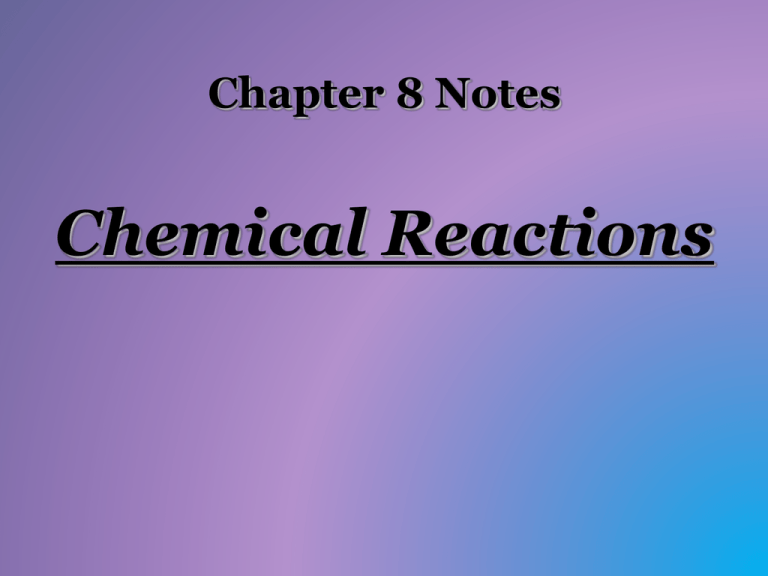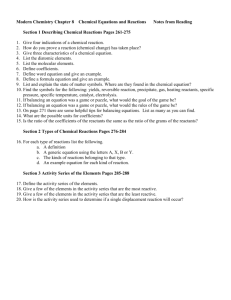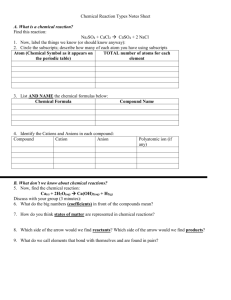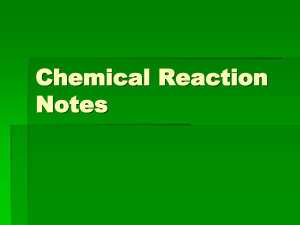(ex. PO 4 3
advertisement

Chapter 8 Notes Chemical Reactions I. Describing Chemical Change • Chemical Equation: Arrow separates the reactants (on left) from the products (on right); plus signs separate multiple reactants and products Ex. Fe + O2 → Fe2O3 • Symbols Used in Chemical Equations: Be sure you have these filled in from page 206 in your textbook • Catalyst: A substance that speeds up a reaction without being used up in the process; often shown above the reaction arrow Ex. H2 + O 2 Pt H2 O • Coefficient: Whole numbers placed to the LEFT of reactants and products; used to balance equations; COEFFICIENTS AND SUBSCRIPTS MULTIPLY • Balanced Chemical Equation: Each side of the equation (left & right sides of the arrow) has the same number of atoms of each element Coefficients represent _____ the ________ ratios of products and reactants, NOT ____________! masses (A Few) Rules for Balancing Chemical Equations: 1. Never change the subscripts (small numbers) in formulas 2. Only use coefficients to balance 3. Remember that coefficients and subscripts MULTIPLY to count atoms 4. Balance one element at a time 5. If polyatomic ions appear on both sides of the equation, treat them as units 6. Make sure all coefficients are in lowest possible ratio (Ex. 1 : 2 : 2 NOT 2 : 4 : 4) 7. PRACTICE, PRACTICE, PRACTICE! *Tip for the very difficult equations: If you have an odd number of atoms of one element on one side of the equation, put a 2 in front of it, then attempt to balance the other side See board for examples Pg. 209: #3 a.) 2 AgNO3 + H2S → Ag2S b.) MnO2 + 4 HCl → MnCl2 + 2 HNO3 +2 H2O + Cl2 4 c.) 3 Zn(OH)2 + 2 H3PO4 → Zn3(PO4)2 (HOH) + 6 H2O Pg. 210: #7 + 6NaOH → 2 Fe(OH)3 a.) 2 FeCl3 b.) CS2 + 3 Cl2 → CCl4 + + 6 NaCl S2Cl2 6 c.) CH4 + Br2 → Balanced! CH3Br + 4 2 HBr II. Types of Chemical Reactions 1. Combination Reaction: Multiple reactants form ONE PRODUCT Ex. A: A + B → AB Ex. B: 2 S + 3 O2 → 2 SO3 2. Decomposition Reaction: ONE REACTANT forms multiple products Ex. A: AB Ex. B: PbO2 → A + B → Pb + O2 3. Single Replacement Reaction: An element replaces another element in a compound; ONE ELEMENT and ONE COMPOUND ON BOTH SIDES Ex. A: A + BX → AB Ex. B: + X 2 Na + ZnO → Zn + Na2O 4. Double Replacement Reaction: an exchange of positive ions between two compounds; TWO COMPOUNDS ON BOTH SIDES Ex. A: AB + XY → AX + BY Ex. B: 3 KOH + AlPO4 → Al(OH)3 + K3PO4 5. Combustion Reaction: An element or compound reacts with O2; O2 IS A REACTANT (on left) Ex. A: CH4 + 2 O2 → CO2 Ex. B: S + O2 → SO2 + 2 H2O Predicting Products in a Double Replacement Reaction: If you remember that in a double replacement reaction, the cations and anions switch places, you can predict the products for the reaction. Just be careful to write the formulas correctly on the product side. (Mg2+ Br1-) Ex. 1: MgCl2 + 2 NaBr → MgBr2 (Na1+ SO42-) Ex. 2: 2 Na3PO4 + Al2(SO4)3 → 3 Na2SO4 (Na1+ Cl1-) + 2 NaCl (Al3+ PO43-) + 2 AlPO4 • Don’t carry the subscripts (little numbers) from the left to the right side of the arrow UNLESS they are part of a polyatomic ion formula (ex. PO43-). • The subscripts are determined the same way here that they were in Ch 6: criss-cross the ionic charges.




